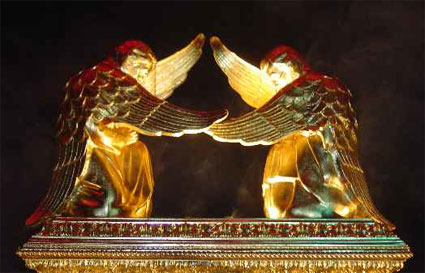A White Stone – 6
“And she saw two angels in white sitting,
one at the head and the other at the feet,
where the body of Jesus had lain.”
- John 20:12
Two Witnesses
The father of the English backpacker who was lost in the Blue Mountains wrote in the visitors book at the hotel where he stayed. He wrote that he was going briefly back into the bush to carve a memorial to his son into one of the rockfaces. Thankfully, as he waited for his flight home to the UK, his son walked out of the wilderness yesterday suffering from hunger and exposure, but alive. As I have discussed in this series [1], the Bible is full of memorials to important events.
Getting God’s people out of the wilderness is a legal procedure. A minimum of two witnesses is required. First, there are two preachers who spy out the enemy and warn them of impending judgment. The feast pattern consistently puts this at “Trumpets”, which helps us identify some of its more subtle appearances:
- Abel’s blood and the Land against Cain
- Noah’s two faithful sons against Ham
- The Lord as the plural elohim against Babel
- The two angels sent to Sodom
- The witness who guides Joseph to his brothers and then Joseph himself as a martyr
- Moses and Aaron sent to Egypt
- Joshua and Caleb’s courageous testimony
- the two spies sent to Jericho
- The Lord and His ‘son’, Ezekiel, whom He continually asks to “see” as a witness against Jerusalem
- the apostolic (firstfruits) church as two witnesses against Herod’s Temple. The literary structure implies they were like the two cherubim at the garden gate with the flaming sword of the gospel. [2]
These are the speaking witnesses. Unlike those who accused Christ, their testimonies do not conflict.
Ten days after Trumpets comes the Day of Atonement. After the ‘ten plagues’, the Lord separates the two goats. His people ascend and the wicked are sent to oblivion. Again there are two witnesses, two memorials.
A Silent Witness
The Bible never teaches that all will eventually be saved (universalism). We see this in Lot’s rescue from Sodom. In this case, the ‘first goat’ was Lot and his daughters. The second was Lot’s wife who looked back. She became a pillar of salt, a ‘whited sepulchre’. Lot became (incestuously) fruitful, but his wife became a silent testimony to the barrenness of the judged cities of the plain.[3] The New Testament repeatedly warned Jewish Christians not to look back like Lot’s wife, like those whose bodies fell in the wilderness. The pattern was happening again.
“…there were two lime-washed pillars that Joshua set up as a memorial to his church’s river crossing. At the church’s crossing of the crystal sea into the promised heavenly country, Herod’s Temple was the second pillar. What was the first?”
The High Priest had ‘holy to the Lord’ written on his forehead. The harlot of Herodian worship also had words written on her forehead. Saints and sinners were marked like the urim and thummim, Ebal and Gerazim, yes and no. The saints were sealed with the mark of the High Priest with the inkhorn. The sinners were sealed with the mark of the beast. Both saints and sinners were written on as memorials to the goodness and severity of God.
Paul speaks of bearing in his body the marks of Christ. The literary structure puts these stigmata at the same position in the structure that gospel witness appears many times before. He was a living epistle [4], a tree cut down, engraved as tablets of flesh with the Torah of Christ by the finger of God, and erected as a pillar in a new Temple.
Of the two stones that witness the church’s exit from the carcass of Judaism, the first was the martyrdom, witness, of saints described in Revelation 14. The old city could not be destroyed until this ‘first goat’ ascended to the Lord as an offering. Like the head, the body became bread and wine, the bread of obedient priesthood glorified with the robe of kingdom.
“I was watching; and the same horn was making war against the saints, and prevailing against them, until the Ancient of Days came, and a judgment was made in favour of the saints of the Most High, and the time came for the saints to possess the kingdom.” (Daniel 7:21-22)
Paul refers to this judgment as the “revelation of the sons of God”, ie. who were the true sons of God, the Jews or the Christians. Which goat was which? Like the earthly High Priest, Christ came down and judged Herod’s Babel in AD70. He took the urim and thummim and decided between the ‘identical’ goats, fulfilling the Day of Atonement.
A Singing Witness
Herod’s white house was made a silent witness forever. The apostolic church now rules from heaven, robed in white in a bridal city. She still gloats over the death of her enemies and sings the songs of Moses and David, the Lamb. Her testimony, carved in the apostles’ flesh, speaks across the globe in every language. To us, the firstfruits church is a permanent token of faithful wilderness priesthood, a manna memorial. We feed on her New Covenant words and are marked by the Spirit for the final Day.
Then one of the elders answered, saying to me, “Who are these arrayed in white robes, and where did they come from?” And I said to him, “Sir, you know.” So he said to me, “These are the ones who come out of the great tribulation, and washed their robes and made them white in the blood of the Lamb.” Revelation 7:13-14
____________________________________________
[1] A White Stone – all articles.
[2] See Slavery to Sabbath in Revelation 5-11
[3] See Don’t Look Back
[4] See Paul the Epistle


























